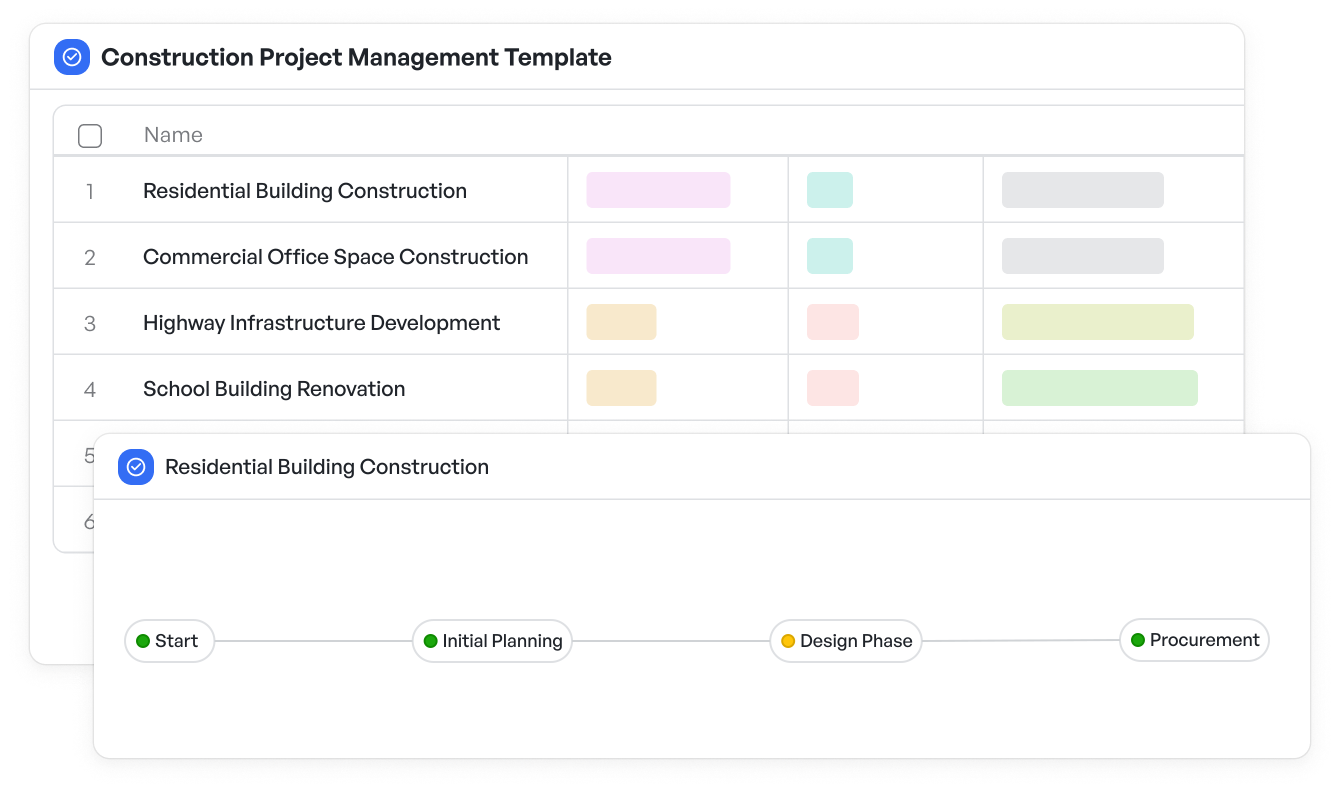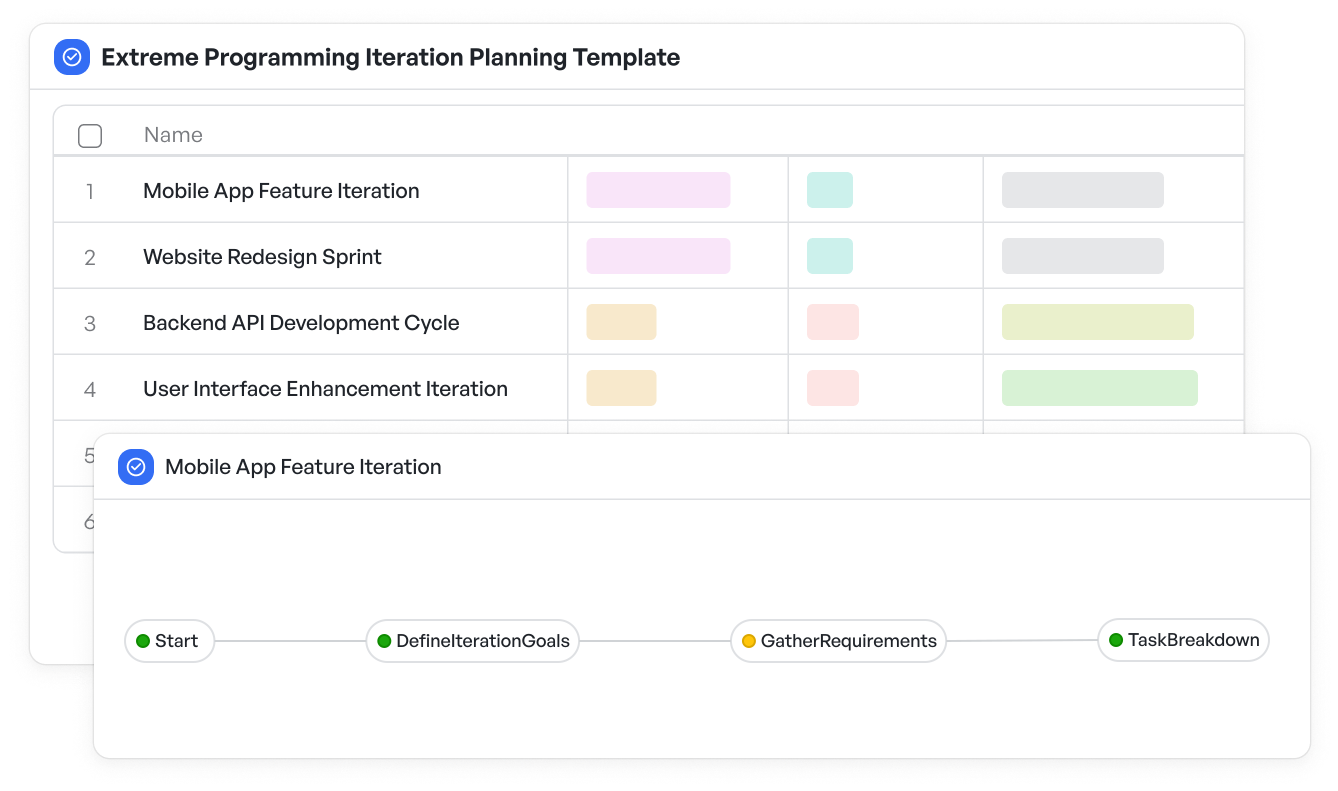How to Implement Extreme Programming in Construction

Extreme Programming (XP), an Agile methodology originally designed for software development, is gaining traction in industries outside of tech—especially in construction. With a focus on collaboration, flexibility, and continuous feedback, XP is uniquely suited to meet the challenges of the fast-paced, high-stakes construction environment.
By adopting XP principles and practices, construction teams can improve project outcomes, enhance efficiency, and deliver high-quality results faster.
In this article, we’ll explore how XP can be applied in the construction industry, its core benefits, and how Meegle’s tools can support construction teams in adopting XP practices.
Understanding Extreme Programming (XP)
Extreme Programming (XP) is a software development methodology that emphasizes customer satisfaction through continuous feedback, iterative development, and high collaboration among teams. While XP was initially designed to address the challenges of software development, its core principles—such as flexibility, rapid iteration, and frequent communication—are highly applicable to construction projects.
The construction industry, with its often complex, high-risk, and customer-focused nature, can benefit from XP by improving communication, reducing risks, and ensuring faster delivery of projects.
Core Values of XP
XP is built around five core values that influence how teams collaborate and develop products. These values can be directly applied to construction projects to improve team dynamics, enhance productivity, and ensure successful project outcomes:
- Simplicity: Focus on simple, efficient solutions that meet the immediate needs of the project. Avoid over-complicating designs or processes, ensuring that resources are used effectively.
- Communication: XP stresses the importance of clear, consistent communication among all stakeholders—designers, contractors, clients, and project managers. In construction, this translates into regular updates, collaboration, and feedback from all parties.
- Feedback: Continuous feedback allows for early identification of issues, helping construction teams make adjustments before problems escalate. This reduces delays and improves the quality of the project.
- Courage: XP encourages teams to take bold actions when necessary. In construction, this means being willing to make changes or implement new ideas that may improve efficiency or quality, even if it means stepping away from traditional methods.
- Respect: Mutual respect among team members fosters a positive work environment. When each team member’s contributions are valued, collaboration becomes more effective, leading to better project outcomes.
Read more: Best Project Management Software for Construction
Key Practices of XP
XP is guided by several practices that help ensure its core values are realized. These practices, when adapted to construction, can lead to significant improvements in project management and delivery.
1. Test-Driven Development (TDD)
In software development, TDD involves writing tests before writing code. For construction, this concept can be applied by ensuring all design and construction requirements are tested and validated before actual work begins. By focusing on clear, predefined quality criteria from the outset, construction teams can avoid costly errors and delays.
2. Pair Programming
Pair programming in XP involves two developers working together on the same task. In construction, this practice could translate into collaborative teamwork where engineers, architects, and construction workers work side by side to design, plan, and execute tasks. This ensures that different perspectives are considered, and problems are identified and addressed quickly.
3. Continuous Integration
In software development, continuous integration means integrating changes frequently and testing them in real-time. In construction, continuous integration could involve ongoing evaluations of project progress, ensuring that designs, materials, and timelines are consistently aligned. This reduces the chances of major issues arising later in the project.
Download Meegle's Construction Project Management Template for free
Build your workflow today!

Benefits of XP in Construction
Implementing XP in construction brings a variety of benefits that improve both the process and the final outcomes of projects.
1. Enhanced Project Management Efficiency
XP’s iterative and incremental approach allows construction teams to focus on manageable tasks, reducing bottlenecks and improving project tracking. By breaking down the work into smaller, more achievable milestones, teams can achieve better project control and faster completion times.
2. Improved Collaboration and Communication
XP emphasizes collaboration and communication among all stakeholders. In construction, this means frequent check-ins, real-time feedback, and shared goals. Improved collaboration ensures that potential issues are identified and addressed quickly, resulting in a more cohesive team effort.
3. Accelerated Timelines and Delivery
With continuous feedback and small, incremental releases, construction projects can be delivered faster. XP practices allow teams to continuously refine designs and processes, ensuring that time is spent only on what adds value, reducing waste and accelerating the overall timeline.
4. Better Risk Management
By breaking down tasks into smaller, manageable parts and providing frequent feedback, XP helps identify risks earlier in the project lifecycle. Early detection allows teams to address potential issues before they escalate, improving risk management and reducing costly delays.
5. Increased Quality Assurance
XP practices like TDD and continuous integration lead to higher quality work throughout the construction process. With defined testing and regular evaluation, construction teams can ensure that each element meets the necessary quality standards before proceeding to the next phase.
Comparing XP with Traditional Construction Management
XP’s approach to project management differs significantly from traditional construction methodologies. Here’s a comparison:
1. Differences in Approach
Traditional construction management often follows a linear process with clearly defined stages—planning, design, execution, and completion. XP, on the other hand, promotes an iterative, flexible approach where teams work in shorter cycles and make ongoing adjustments based on feedback.
2. Advantages Over Conventional Methods
XP provides several advantages over traditional methods, including more flexibility, faster feedback loops, and better quality assurance. This is especially beneficial in construction, where projects can be highly dynamic, and requirements often evolve over time.
3. Limitations and Challenges
While XP has many advantages, it also presents challenges when compared to traditional construction management.
- One key limitation is that XP requires a cultural shift, and not all stakeholders may be comfortable with the constant iteration and feedback required.
- Additionally, XP may require more up-front training and adoption of Agile principles by all team members.
Integration of XP Practices in Construction
To implement XP successfully in construction, companies need to adapt key practices to suit the unique requirements of the industry.
1. Adapting Test-Driven Development (TDD) for Construction
TDD in construction can be adapted to ensure that all designs and materials meet specified requirements before construction begins. By validating these requirements early, construction teams can avoid costly rework and ensure that the project progresses smoothly.
2. Implementing Continuous Integration
In construction, continuous integration can be applied by evaluating project progress regularly and ensuring that designs, materials, and methods are consistently aligned. This helps to reduce the risk of major issues arising later in the project.
3. On-Site Customer Collaboration
XP encourages constant collaboration with customers to ensure the final product meets their expectations. In construction, this means engaging with clients and stakeholders regularly to gather feedback on design choices, progress, and changes.
Use Meegle's Extreme Programming Iteration Planning Template for free.

Cultural Shift Required for XP Implementation
Implementing XP in construction requires a significant cultural shift. Teams need to embrace change, adaptability, and continuous feedback, which can be difficult in industries that are traditionally more structured.
1. Embracing Change and Adaptability
Construction companies must foster an environment where change is welcomed and seen as an opportunity for improvement. This requires leadership buy-in and a willingness to invest in Agile training for teams.
2. Training and Skill Development
As XP is an Agile methodology, teams must be trained in Agile principles and practices, which may differ from traditional project management techniques used in construction.
3. Building a Supportive Work Environment
Creating a culture of collaboration, transparency, and respect is critical to XP’s success in construction. Leaders must encourage open communication and provide support as teams adopt these new practices.
Challenges of Applying XP in Construction
Adopting XP in construction is not without its challenges. These include:
1. Transitioning from Software-Centric to Construction Processes
XP was initially designed for software development, and applying it to construction requires adapting practices to fit the unique needs of the industry.
2. Overcoming Resistance to Change
Resistance to adopting new methods is a common challenge in construction, particularly when dealing with traditional teams or well-established processes.
3. Balancing XP with Existing Frameworks
Construction companies may already be using established project management frameworks. Integrating XP with these existing methods requires careful planning and gradual implementation.
Comparing XP with Other Agile Frameworks
XP shares many similarities with other Agile frameworks, but there are some key differences that make it especially suited for certain construction projects.
1. XP vs. Scrum in Construction
Both XP and Scrum focus on iterative development, but XP places a greater emphasis on engineering practices like TDD and continuous integration. Scrum, meanwhile, is focused more on organizing workflows and managing teams. In construction, XP is more beneficial for improving product quality, while Scrum may be better for managing team roles and project timelines.
2. XP vs. Kanban in Construction
Kanban focuses on managing workflow and improving efficiency by visualizing tasks. XP, by contrast, focuses more on quality control and ensuring that products meet customer expectations. Combining both methodologies could provide a balanced approach in construction projects.
Unlocking the Full Potential of Extreme Programming in Construction
Extreme Programming offers construction companies a flexible, customer-focused approach to project management that can significantly improve efficiency, quality, and collaboration. By embracing XP’s core values and practices, construction teams can stay agile in a rapidly changing environment, continuously improving their processes and outcomes.
Meegle’s resources enable construction companies to embrace continuous improvement while ensuring high-quality outputs.
Build your workflow today!
The world’s #1 visualized project management tool
Powered by the next gen visual workflow engineRead More
Check All BlogsStart creating impactful work today



